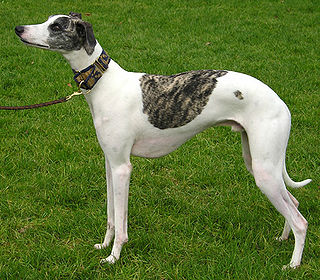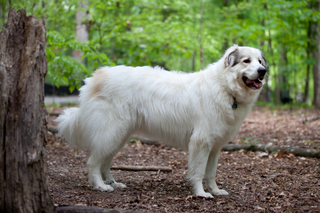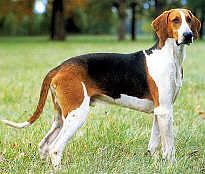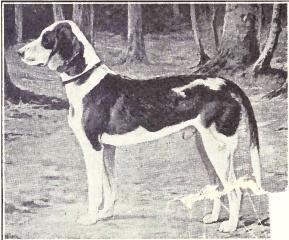
The Ibizan Hound is a lean, agile dog of the hound family. There are two hair types of the breed: smooth and wire. The more commonly seen type is the smooth. Some consider there to be a third type, long, but the longhair is most likely a variation of the wire.

Sighthounds are a type of hound dog that hunts primarily by sight and speed, unlike scent hounds, which rely on scent and endurance.

A hound is a type of hunting dog used by hunters to track or chase prey.

A dog breed is a particular type of dog that was purposefully bred by humans to perform specific tasks, such as herding, hunting, and guarding. Dogs are the most variable mammal on Earth, with artificial selection producing upward of 360 globally recognized breeds. These breeds possess distinct traits related to morphology, which include body size, skull shape, tail phenotype, fur type, body shape, and coat colour. However, there is only one species of dog. Their behavioral traits include guarding, herding, and hunting, and personality traits such as hyper-social behavior, boldness, and aggression. Most breeds were derived from small numbers of founders within the last 200 years. As a result of their adaptability to many environments and breedability for human needs, today dogs are the most abundant carnivore species and are dispersed around the world.

Scent hounds are a type of hound that primarily hunts by scent rather than sight. These breeds are hunting dogs and are generally regarded as having some of the most sensitive noses among dogs. Scent hounds specialize in following scent or smells. Most of them tend to have long, drooping ears and large nasal cavities to enhance smell sensitivity. They need to have relatively high endurance to be able to keep track of scent over long distances and rough terrain. It is believed that they were first bred by the Celts by crossbreeding mastiff-type dogs with sighthounds. The first established scent hounds were St. Hubert Hounds bred by monks in Belgium during the Middle Ages.

The Pyrenean Mountain Dog or Chien de Montagne des Pyrénées is a French breed of livestock guardian dog; in France it is commonly called the Patou. It originates from the eastern or French side of the Pyrenees Mountains that separate France and Spain and is recognised as a separate breed from the Mastín del Pirineo or Pyrenean Mastiff from the Spanish side of the mountains, to which it is closely related.

The Serbian Hound, previously known as the Balkan Hound, is a breed of scent hound from Serbia.
Lure coursing is a sport for dogs that involves chasing a mechanically operated lure. Competition is typically limited to dogs of purebred sighthound breeds. The AKC has a pass/fail trial for all breeds called the Coursing Ability Test (CAT) and a timed 100 yard dash called Fast CAT where the dog's speed is converted to points.

A mastiff is a large and powerful type of dog. Mastiffs are among the largest dogs, and typically have a short coat, a long low-set tail and large feet; the skull is large and bulky, the muzzle broad and short (brachycephalic) and the ears drooping and pendant-shaped. European and Asian records dating back 3,000 years show dogs of the mastiff type. Mastiffs have historically been guard dogs, protecting homes and property, although throughout history they have been used as hunting dogs, war dogs and for blood sports, such as fighting each other and other animals, including bulls, bears and even lions.

The Cirneco dell'Etna is an Italian breed of hunting dog from the Mediterranean island of Sicily. It is named for the Etna volcano in eastern Sicily. It has a keen sense of smell, and is used to hunt small game, particularly rabbits. As with many working dogs, registration is conditional on successful completion of a working trial.

The Tatra Shepherd Dog is a Polish breed of large flock guardian dog originating in the Tatra Mountains of the Podhale region of southern Poland. It was fully recognised by the Fédération Cynologique Internationale in 1963. It is one of five dog breeds originating in Poland, the others being the Polish Greyhound, the Polish Hound, the Polish Hunting Dog and the Polish Lowland Sheepdog.

The Segugio Italiano is either of two Italian breeds of dog of scent hound type, the wire-haired Segugio Italiano a Pelo Forte or the short-haired Segugio Italiano a Pelo Raso. Apart from the coat type, they are closely similar, and in some sources may be treated as a single breed; the Fédération Cynologique Internationale and the Ente Nazionale della Cinofilia Italiana treat them as separate. They are also genetically close to the other two Italian scent hound breeds, the Segugio Maremmano and the Segugio dell'Appennino. They are traditionally used for hunting hare, but may also be used in boar hunts.

The Anglo-Français de Petite Vénerie is a medium-sized breed of dog used in hunting as a scenthound, usually in packs. It is one of the Anglo-French hound breeds which were created by crossing French scenthounds with English foxhounds. The name Petite Vénerie does not mean that dogs of the breed are petite or small, but rather that it is used to hunt small game.

The Transylvanian Hound, also known as the Transylvanian Scent Hound or Hungarian Hound, is a Hungarian breed of scent hound used primarily for hunting. It originated in the former Kingdom of Hungary in the historical region of Transylvania, which is now part of Romania. It is strong and of medium size, characterized by a black body with tan and sometimes white markings on the muzzle, chest and extremities, and distinctive tan eyebrow spots. It has a high-pitched bark for a dog of its size. The breed was rescued from extinction by focused breeding efforts in the late twentieth century. There were formerly two varieties, the tall and the short, developed for different kinds of hunting in the Middle Ages. Only the tall variety survives today.

Podenco Canario is a breed of dog from the Canary Islands. The Podenco Canario is still used today, primarily in packs, most often for the sport hunting of rabbits. The word "podenco" in Spain refers to a certain type of dog, typically rabbit hunters with the same body shape. "Canario" is a reference to its region of origin, the Canary Islands. The Spanish Kennel Club, Real Sociedad Canina de España, recognises the following similar dog breeds that use the identifier "podenco" in their names: Podenco Andaluz, Podenco Ibicenco, and Podenco Valenciano.

The Westphalian Dachsbracke is a small, short-legged scenthound, a breed of dog originating in Westphalia, a region of Germany. The Westphalian Dachsbracke was used in Sweden to develop the Drever.

Anglo-Français and Français hounds are a general dog type of hunting dog that include ancient French hounds and breeds created by mixing the French dogs with English (Anglo) Foxhounds. There are seven dog breeds that are described as Anglo-Français and Français hounds.

The German Hound is a breed of dog originating in Westphalia, a region of Germany. The German Hound is of the scenthound type, used for hunting both large and small game.

The Podenco Andaluz is an ancient Spanish breed of warren hound used to hunt small game in Andalusia, Spain. It is one of four podenco breeds recognized by the Real Sociedad Canina de España. It is an agile dog generally used to hunt ducks, rabbits, boar and fowl. There are three accepted sizes and three coat types.

Tesem was the ancient Egyptian name for "hunting dog". In popular literature it denotes the prick-eared, leggy dog with a curled tail from the early Egyptian age, but it was also used with reference to the lop-eared "Saluki/Sloughi" type. It was one of several types of dogs in Ancient Egypt; particularly the latter Saluki/Sloughi type of Tesem, having the appearance most similar to that of a true sighthound.



















